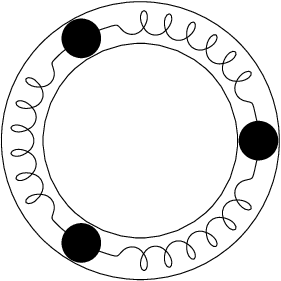PyX — Gallery: path/springs.py
Deforming paths

# contributed by Gert-Ludwig Ingold from pyx import * n = 3 # number of masses r = 3.0 # system radius rcyc = 0.3 # radius of cycloid nl = 13 # number of loops rc = 0.5 # radius of masses eps = 0.03 # extra spacing for surrounding circles c = canvas.canvas() springcircle = path.circle(0, 0, r) masspositions = [i*springcircle.arclen()/n for i in range(n)] for springsegment in springcircle.split(masspositions): c.stroke(springsegment, [deformer.cycloid(rcyc, nl), deformer.smoothed(radius=0.1)]) for x, y in springcircle.at(masspositions): c.fill(path.circle(x, y, rc)) c.stroke(springcircle, [deformer.parallel(rc+eps)]) c.stroke(springcircle, [deformer.parallel(-rc-eps)]) c.writeEPSfile() c.writePDFfile() c.writeSVGfile()
Description
In this example, another type of stroke attributes is demonstrated, namely the deformers. They take an original curve and return a modified one. Here, the first deformer bends three arcs into spirals, the next one smooths the result a bit.
In the example code, a circle is first created and then split into three segments. Each segment of the arc is then stroked with deformer.cycloid and deformer.smoothed, which create the spring-like look of the segments. The cycloid does not start at the very beginning of the original path. Instead, it first follows the original path for a certain length and then starts, yielding a sharp corner. This corner is smoothed a bit by the second deformer.
Note that the order of the deformer attributes is not arbitrary, since the deforming operations do not commute.
The two circles surrounding the springs are not created as simple circles but rather as the curves with constant distance to the original circle. This demonstrates the use of a third deformer, namely deformer.parallel.
